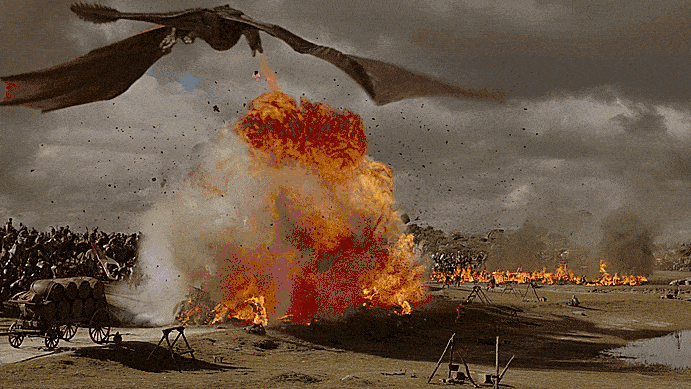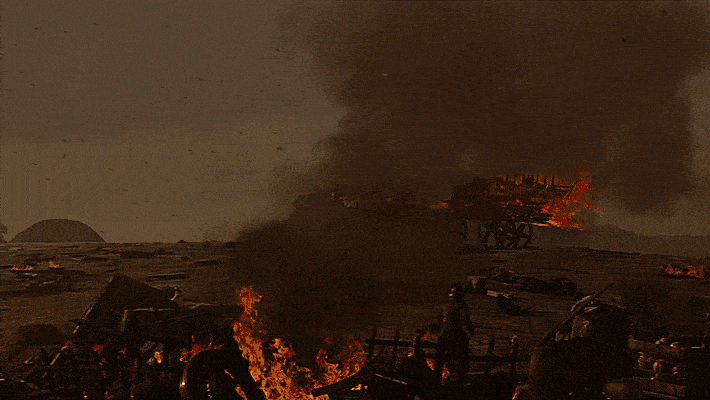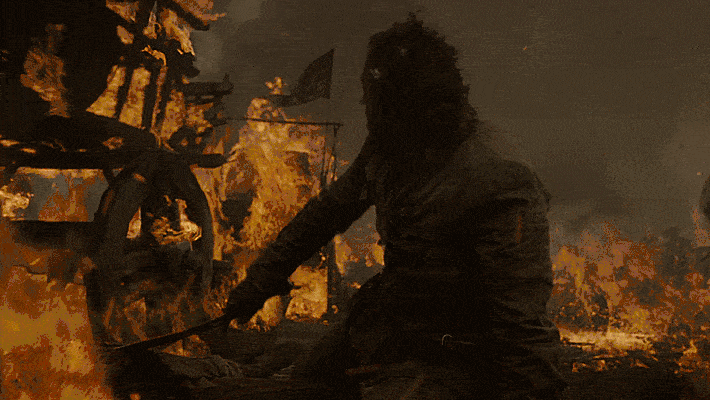Although the White Walkers might be the Big Bads of the series, the battle within ‘The Spoils of War’ remains the most thematically important one of the entire series. Game of Thrones at its best has always been about showing the audience shades of grey: the horror of the war in the Riverlands contrasted against Robb Stark’s victories there; the arcs of characters like the Hound and Jaime who perform seemingly unforgivable acts only to redeem themselves in the years that follow. The recent seasons’ focus on the war against the dead has allowed the show’s writers to move away from the moral complexity of their early-season story-lines in a streamlined and simplified fashion. Good versus evil. Living versus the dead.
This simplification has removed much of the nuance from the way that A Song of Ice and Fire presents war. In his first five novels, author George R.R. Martin, a conscientious objector during the Vietnam war, strikes out from the high fantasy template of faceless evil to instead focus upon the real-world morality of war. Although he is a passionate fan of genre icon J.R.R.Tolkien, Martin has frequently spoken about how his brand of fantasy is inherently different:
“The war that Tolkien wrote about was a war for the fate of civilization and the future of humanity, and that’s become the template. I’m not sure that it’s a good template, though. The Tolkien model led generations of fantasy writers to produce these endless series of dark lords and their evil minions who are all very ugly and wear black clothes. But the vast majority of wars throughout history are not like that. World War I is much more typical of the wars of history than World War II – the kind of war you look back afterward and say, “What the hell were we fighting for? Why did all these millions of people have to die? [. . .] Men are still capable of great heroism. But I don’t necessarily think there are heroes. That’s something that’s very much in my books: I believe in great characters. We’re all capable of doing great things, and of doing bad things. We have the angels and the demons inside of us, and our lives are a succession of choices.”
The ‘Spoils of War’ battle sequence is the last and best example of those shades of grey, as on some level, audiences are rooting for both sides equally. Jaime Lannister (Nicolaj Coster-Waldau) sees Daenerys Targaryen (Emilia Clarke) as a tyrant and the embodiment of her father’s cruelty and insanity. Daenerys sees Jaime as a traitorous villain who betrayed his oaths to her family and murdered her father.
The sequence opens in a fashion remarkably similar to a classic western. Filmed in Cáceres, Spain, nestled amongst green plains and looming buttes, the Lannister army is alerted to the incoming force by the cadence of hoof beats and the trills of Dothraki screamers. Although clearly inspired by the Mongols, Martin also cites Amerindian influences including “Alans, Sioux, Cheyenne, and various other Amerindian tribes… seasoned with a dash of pure fantasy.” The Lannisters immediately circle the wagons to defend their loot.

The charging Dothraki are terrifying for reasons well beyond their sheer numbers. Thrones horse-master Camilla Naprous brought in trick-riders who could stand up on their saddles and enhance the inhuman marvel of a horse-back horde. There is an excellent shot of a Dothraki screamer leaping over the Lannister spear-wall and landing directly into action. Their whooping cries as they approach the Lannister line are more than just a sound effect; they are intended to strike fear into their opponents and scare them into breaking formation. Jaime seems confident they can hold off the Dothraki, but then a new cry echoes across the plains — Daenerys arrives on dragonback, and it stops being a battle of equals and turns instead into a complete slaughter.
Director Matt Shakman took inspiration from season six’s “Battle of the Bastards” for the emotional core of the episode and in the choice of the right POV to follow through the battle. This is the first time that dragons have been unleashed on fellow protagonists, and Jaime sees it first-hand from the ground. Not only are the Lannisters out-manned and stuck defending a static position without the mobility of any cavalry, but they are also depleted from their recent victory at Highgarden and the subsequent march. On top of all that, they watch their world change as the equivalent of an F-18 fighter jet is introduced to a medieval battlefield. Seeing all of these men burning alive is Jaime’s worst fear as he’s brought face to face with a horror that he thought he had prevented by killing the Mad King.

Unlike northern battles like Hardhome or the battle at Castle Black, this southern skirmish is resplendent in color. Bright green fields are reduced to ash; red and gold Lannister colors are consumed by dragon fire. Shakman used a variety of filming techniques to show the battle from all angles. It involves more dragonback scenes than the rest of the show combined and includes elaborate dragon points-of-view and high-speed shots (including cameras moving up to 70 mph). Shakman took inspiration from helicopter shots in Apocalypse Now showing air attacks before cutting to the ground where the villagers are being consumed by napalm. To make the ground sequences here feel visceral and real, Thrones set a filming record in this episode by having the most stunt people on fire with twenty at one time and a total of 73 for the whole sequence.
Although Jaime is the main point-of-view for this battle, Shakman took some asides into other character perspectives throughout the sequence. A long shot (actually three spliced together) follows Bronn (Jerome Flynn) through the ashen chaos of the battle. This sequence provides a stark contrast from the high and far shots of Drogon incinerating Lannisters to the confusion on the ground. Game of Thrones does best when it gives these contrasts between the glory of war and the cost that it extracts from those involved in it. This is something that Daenerys has struggled with throughout the series: whether she wants to be a conqueror or a conciliator, whether she wants to be a Queen or an avenging dragon.

Tyrion (Peter Dinklage) watches the battle from a nearby hilltop and acts as a stand-in for the perspective of the audience. A lot of common-folk die horrible deaths in this war between the high lords. Tyrion watches as many of the men that he commanded at the Blackwater (and may have known from his childhood at Casterly Rock) are horrifically slaughtered. He watches a Queen that he believes in plummeting towards the ground on an injured dragon, and the brother he loves charging headfirst into dragon fire. Despite all this horror, it’s supposedly a victory for him. His internal conflict exemplifies the war themes that have permeated Game of Thrones from the beginning. Rather than being a battle between good and evil, it is simply two different sides with each composed of humanity’s dual nature.
The post Game of Thrones: The Masterful Perspective of ‘The Spoils of War’ appeared first on Film School Rejects.



0 comments:
Post a Comment